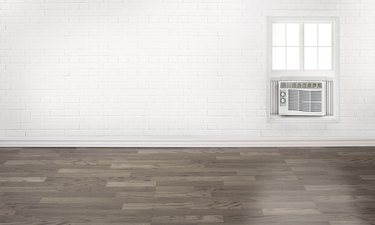
Window and through-the-wall air conditioners look similar, but they have some major differences that can help you decide between the two. Both are meant to cool a single room, unlike a central air conditioning unit that's part of the HVAC system and cools the entire house. The installation and design of the two types vary slightly to fit the installation location. Looking at the differences can help you determine which type best matches your cooling needs.
Tip
Window and through-the-wall air conditioners operate in a similar way, but there are significant differences, including the venting and installation. Window air conditioners vent to the sides and go into an existing window, while wall air conditioners vent to the back and go through a hole cut in an exterior wall.
Video of the Day
Window Air Conditioner Installation
Window air conditioners usually have vents on the sides and back. Since they go through a window that's already there, window ACs are much easier to install. They're not permanent like a wall unit, so you can easily move them to new locations or decide to stop using them whenever you want. The main drawback is that the unit blocks the window while it's installed, so you can't open it for fresh air or use it as an emergency escape route.
Video of the Day
Through-the-Wall Air Conditioner Installation
A through-the-wall air conditioner goes through a hole cut in an exterior wall of your home. A frame lines the hole to support the air conditioner, which has vents on the back instead of on the sides like a window unit. Side vents would send the heat into the wall and possibly overheat the unit, which is a major reason wall and window air conditioners aren't interchangeable. When installed, a wall AC usually doesn't stick out much beyond the exterior wall.
Since it's installed through a hole in the wall, this type of AC stays in year-round. Once installed, it's less work since you don't have to install and uninstall it every year. It also leaves your windows free as an escape route, to open for fresh air or to let in more sunlight. The major drawback is the more complex installation initially. It's often best to hire a professional since you need to avoid electrical wires and plumbing pipes that run through the walls.
This option is good in rooms without windows or if you only have one window, and you don't want to block it. They also work well for homeowners who want a permanent installation that stays in place.
Comparison of Energy Efficiency
The energy efficiency of the air conditioning units is similar between both types. You can find a range of energy-efficiency levels for window and wall AC units. Looking at the energy-efficiency ratio helps you compare the energy efficiency of different models.
When installed and insulated properly, wall units can make your home slightly more energy efficient overall. Since the unit goes through a hole cut to its specific size, it can be made airtight. This keeps the room better insulated without letting cooled air escape. A window air conditioner isn't airtight, so it's often not as energy efficient overall.
Air Conditioner Cooling Power
Both window and wall air conditioners come in a range of AC sizes, which determines how much space it can cool. They're both typically limited to the immediate room in which they're located for cooling. The size range for window air conditioners tends to go larger, with more cooling power than through-the-wall units, which means you can choose a window unit with more cooling power for larger rooms. Using a tape measure to calculate the area of the room helps you choose the correct size of either type.
Window vs. Through-the-Wall AC Costs
The air conditioner costs are similar for window and through-the-wall air conditioners, with both being the cheapest air conditioning options. According to HomeAdvisor, window air conditioners typically range from $150 to $1,100, while wall ACs range from $450 to $700. The specific cost varies based on the cooling power of each model and any extra features, such as smart air conditioners with apps to control the unit from anywhere. Since window units are typically available in larger sizes, the upper end of the price range is a little higher.
The installation can make the difference. Installing a window unit is relatively easy and something most homeowners can do on their own. Even if you have it professionally installed, a window unit's installation will be cheaper since it's easier.
Another issue is window air conditioner malfunction. A through-the-wall unit that needs a significant repair or maintenance work is harder to deal with than a window AC unit, which can easily be taken out of the window for disassembly or a deep cleaning.
A wall unit requires a hole cut to a specific size. It takes more work to avoid wires and pipes in the wall and to create the necessary support. For this reason, some homeowners might prefer professional installation, which adds to the overall cost.